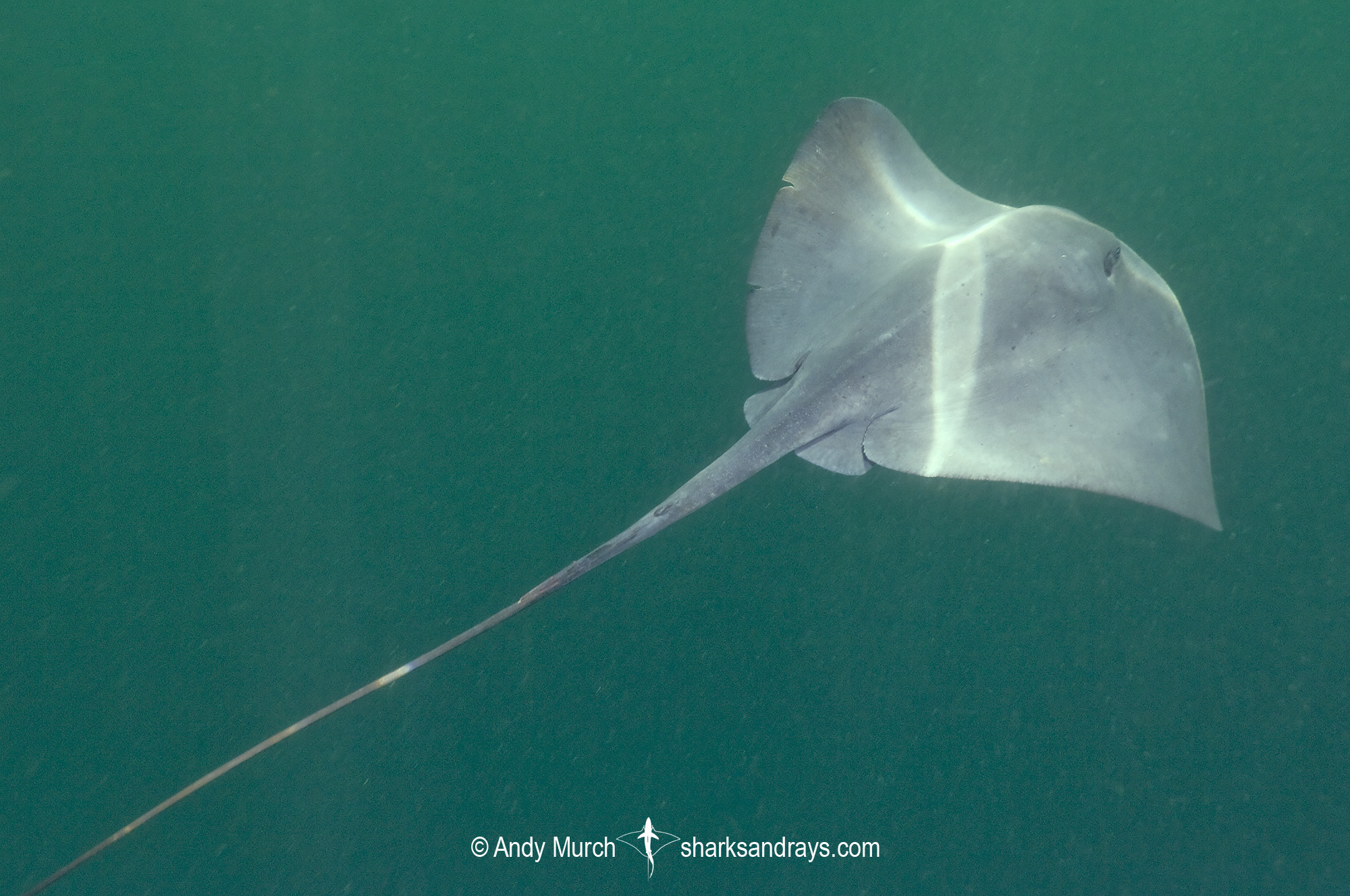Common name(s)
Pelagic Stingray.
Identification
A medium sized stingray with a thick trunk and wide arc-shaped disc; width approximately 1.3-1.4 x length. Anterior margin of disc broadly curved with a small protruding apical lobe. Pectoral fin apices narrowly rounded or angular. Pelvic fins short.
Eyes very small. Snout length 1.1-1.3 x combined eye and spiracle length.
Mouth small with numerous bifurcated oral papillae. Prominent labial furrows and folds around mouth. Lower jaw mildly convex. Wide, short, skirt-shaped nasal curtain with a weakly fringed posterior margin. Nostrils circular.
Row of small thorns present on midline from nape to caudal sting. Granular denticles present in large females. Tail wide and depressed at base, tapering gently to tail sting, then whiplike to tip. Tail length (when intact) approximately 2x disc width. Dorsal finfold ridge-like or absent. Ventral fold thin and long; extending onto posterior section beyond caudal sting. 1-2 tail stings usually present.
Colour
Dorsum grey, violet-grey, or black. Ventrum similar but lighter than dorsum. Tail variable; pale, dusky, or black.
Size
Maximum disc width 90cm. Disc width at birth 14-24cm.
Habitat
Temperate and Tropical seas. The only species of stingray that inhabits the pelagic zone. Also occurs on the sand. Found from the surface to 381m but usually shallower than 100m.
Distribution
The Pelagic Stingray occurs circumglobally in all tropical and temperate oceans.
Conservation Status
LEAST CONCERN
The major threat to the Pelagic Stingray are pelagic longline fisheries for tunas, billfishes, and pelagic sharks (Neer 2008). This species is caught frequently by tuna and swordfish longliners and to a lesser extent other gear, including pelagic gillnets and trawls (Hemida et al. 2003). In the Atlantic, between 2008 and 2011, the species was the fifth most commonly captured bycatch species on longline vessels targeting swordfish (Xiphias gladius) (Coelho et al. 2012). It is of low commercial value and mostly discarded, although it is retained and utilized in some areas (Mollet 2002, Domingo et al. 2005, White et al. 2006, Forselledo et al. 2008, Baez et al. 2015). In some regions, such as the South Atlantic and Europe, there is a low discard survival rate due to damage to jaws as a result of treatment on-board fishing vessels (Domingo et al. 2005, Forselledo et al. 2007). Variable catches are reported globally, for example, approximately 2,000 individuals were captured over 5 years to 2005 by the Uruguayan longline fleet in the south Atlantic and 57,500 individuals taken by the Spanish longline fleet in the Mediterranean over 13 years to 2013 (Domingo et al. 2005, Forselledo et al. 2007, Baez et al. 2015).
Citation
Kyne, P.M., Barreto, R., Carlson, J., Fernando, D., Francis, M.P., Fordham, S., Jabado, R.W., Liu, K.M., Marshall, A., Pacoureau, N., Romanov, E., Sherley, R.B. & Winker, H. 2019. Pteroplatytrygon violacea. The IUCN Red List of Threatened Species 2019: e.T161731A896169. https://dx.doi.org/10.2305/IUCN.UK.2019-1.RLTS.T161731A896169.en. Downloaded on 24 February 2021.
Reproduction
Matrotrophic viviparity. Litter size 2-9. Gestation 2-4 months.
Diet
Diet consists jellyfishes, squid, crustaceans, and small fishes.
Behavior
An active swimmer that spends much of its time far from the substrate.
Reaction to divers
Shy and difficult to approach. Usually swims away immediately if approached.
Diving logistics
Sightings of pelagic stingrays can occur virtually anywhere but they are very rare and difficult to predict. In the Mediterranean they appear to be relatively common in spring and early summer (Jaime Penadés intel).
What’s new
View our full list of updates
Similar species
No other stingrays have an arc-shaped disc or occur in the pelagic zone.







